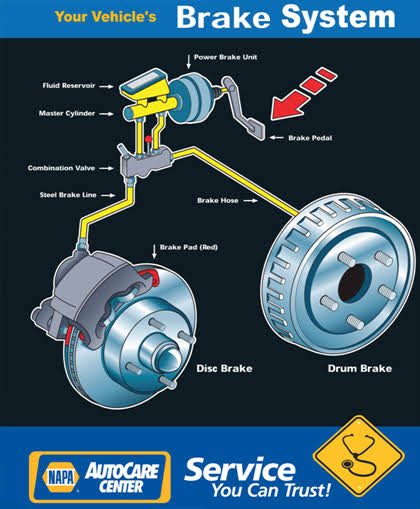AUTOCARE WITH DAMILARE: Brake Fluids
Brake Fluids
The brake system in your vehicle allows the driver to slow down or stop in a consistent and reliable manner. The brakes on your car work by converting the kinetic energy of movement into thermal energy (heat).
Each time you step on the brake pedal, the speed of the spinning wheels underneath your vehicle is reduced proportionately to how much pressure you apply to the pedal. A vehicle will have either a disc braking system or drum braking system to create the necessary friction for this to take place.
Brake fluid is one of the most essential fluid in your car. Most cars use hydraulic brake systems and such type of system needs brake fluid. This fluid is a type of hydraulic liquid that transfers force into pressure, from the pedal to the calipers. Often, you may find one based in glyco-ether known for having high boiling points, while mineral and silicone-based are also available.
Brake fluid is an integral part of the hydraulic brake system. Brake pressure forces fluid to the brakes, causing the pads to clamp down on the rotors, attached to the wheel hubs that spin as the wheel turns. The high pressure causes the car to slow down. Without any brake fluid, no pressure can be created to stop the car. Brake systems are completely sealed to assist in creating pressure. If there is a leak in the system, and the vehicle is losing brake fluid, your brakes will not be able to function well, or at all. Brake fluid leaks can be very dangerous and for safety’s sake, it’s best to avoid driving the vehicle until a professional can fully inspect the system.
How Often to Flush Brake Fluid
Brake systems are completely sealed and with so many components including the brake pedal, reservoir, brake lines, cylinders, pistons, and brake fluid, at some point damage can occur that may cause brake fluid leaks which will greatly affect brake performance. While an inspection of your brake system should be performed at every oil change to check for wear or leaks, a brake flush should be completed every 30,000 miles. Keep in mind that a brake flush differs from a brake bleed. A brake flush removes all fluid from the system via a vacuum and replaces the system with clean fluid. A brake bleed only removes enough brake fluid to remove any air bubbles out of the brake lines.
A soft brake pedal or any sudden changes in braking is an indication that a leak has occurred. In these situations, it’s best to pull over and check the brake fluid level in the reservoir. Any level under three-quarters full should be concerning. Because the system is sealed, the fluid should remain nearly full, however, some fluid loss is normal with regular use. If you are concerned that a brake fluid leak is present, have your vehicle towed to an auto repair center for an immediate inspection. Do not risk your safety or the safety of others by attempting to drive with brakes that could be compromised
Post by: Oriyomi Oluwadamilare Dolapo
Facebook: Oriyomi Oluwadamilare Dolapo
Instagram: oo_oluwadamilare
Twitter: oo_damilare
JOIN THE COMMUNITY!!!
Instagram: https://instagram.com/thetellrhodescommunity
Facebook: The Tellrhodes Blog
WhatsApp: https://wa.me/2348071110893
Gmail: tellrhodes@gmail.com





Comments
Post a Comment